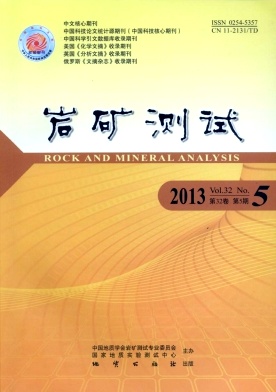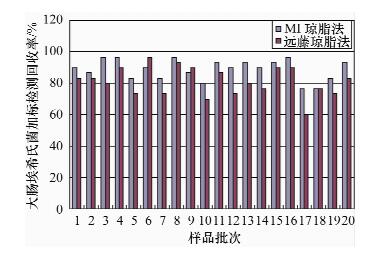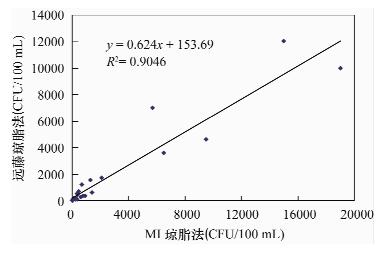| [1] |
王秀茹.预防医学微生物学及检验技术[M].北京:人民卫生出版社, 2002: 676-679.
Google Scholar
|
| [2] |
魏复盛.水和废水监测分析方法[M].北京:中国环境科学出版社, 2002: 696-700.
Google Scholar
|
| [3] |
赵春霞,张哲海,厉以强,梅卓华,郭晓颖,沈燕飞.酶底物法检测环境水样大肠菌群的探讨[C]//中国环境科学学会学术年会论文集.北京:北京航空航天大学出版社, 2009: 502-507.
Google Scholar
|
| [4] |
Francy D S, Darner R A. Comparison of methods for determining Escherichia coli concentrations in recreational waters [J].Water Research,2000,34(10): 2770-2778. doi: 10.1016/S0043-1354(00)00031-2
CrossRef Google Scholar
|
| [5] |
Annie R, Pierre S, Julia B, Marie-Renée R, Patrick L. Detection and enumeration of coliforms in drinking water: Current methods and emerging approaches [J]. Journal of Microbiological Methods,2002,49(1):31-54. doi: 10.1016/S0167-7012(01)00351-7
CrossRef Google Scholar
|
| [6] |
吴清平,周艳红,蔡芷荷.卫生微生物特异性显色培养基的研究与应用[J].中国卫生检验杂志, 2005, 15(1): 124-126.
Google Scholar
|
| [7] |
HÖrmana A, HÖnninena M. Evaluation of the lactose Tergitol-7, m-Endo LES, Colilert 18, Readycult Coliforms 100, Water-Check-100, 3M Petrifilm EC and DryCult Coliform test methods for detection of total coliforms and Escherichia coli in water samples [J]. Water Research, 2006, 20(17): 3249-3256.
Google Scholar
|
| [8] |
Manafi M. New developments in chromogenic and fluorogenic culture media [J]. International Journal of Food Microbiology, 2000, 60(3): 205-218.
Google Scholar
|
| [9] |
US EPA Method 1604,Total Coliforms and Escherichia coli in Water by Membrane Filtration Using a Simultaneous Detection Technique (MI Medium) [S].
Google Scholar
|
| [10] |
GB/T 5750.12—2006,生活饮用水标准检测方法;微生物指标[S].
Google Scholar
|
| [11] |
Wohlsen T, Bates J, Vesey G, Robinson W A, Katouli M. Evaluation of the methods for enumerating coliform bacteria from water samples using precise reference standards [J]. Letters in Applied Microbiology,2006,42(4):350-356. doi: 10.1111/lam.2006.42.issue-4
CrossRef Google Scholar
|
| [12] |
张明德,蔡云龙,白晓慧.城市供水系统中的水质微生物安全与评价[J].给水排水, 2010, 36(Z1): 30-33. doi: 10.3969/j.issn.1002-8471.2010.z1.009
CrossRef Google Scholar
|
| [13] |
Andrée F M, Vicky H, Boissinot M, Franois J P, Luc B, Jean-Luc T B, Michel G B. Analytical limits of four β-glucuronidase and β-galactosidase-based commercial culture methods used to detect Escherichia coliand total coliforms [J]. Journal of Microbiological Methods,2008,75(3):506-514. doi: 10.1016/j.mimet.2008.08.001
CrossRef Google Scholar
|
| [14] |
Eaton A D, Clescen L S, Rice E W, Greenberg A E. Standard Methods for the Examination of Water and Wastewater [M].Washington, D C: American Public Health Association,2005: 959-970.
Google Scholar
|
| [15] |
Olstadt J, Schauer J J, Standridge J, Kluender S. A comparison of ten USEPA approved total coliform/E. coli tests [J].Journal of Water and Health,2007, 5(2):267-282.
Google Scholar
|
| [16] |
Hamilton W P, Kim M, Thackston E L.Comparison of commercially availableEscherichia coli enumeration tests:Implications for attaining water quality standards [J].Water Research,2005,39(20):4869-4878. doi: 10.1016/j.watres.2005.02.006
CrossRef Google Scholar
|
| [17] |
Hallas G, Giglio S, Capurso V, Monis P T, Grooby W L. Evaluation of chromogenic technologies for use in Australian potable water[J]. Journal of Applied Microbiology, 2008, 105(4):1138-1149. doi: 10.1111/jam.2008.105.issue-4
CrossRef Google Scholar
|
| [18] |
Chao K, Chao C, Chao W. Evaluation of colilert-18 for detection of coliforms and Eschericha coli in subtropical freshwater [J]. Applied and Environmental Microbiology, 2003, 70(2):1242-1244.
Google Scholar
|
| [19] |
Watkinson A J, Micalizzi G R, Bates J R, Costanzo S D. Novel method for rapid assessment of antibiotic resistance in Escherichia coli isolates from environmental waters by use of a modified chromogenic agar [J]. Applied and Environmental Microbiology, 2007, 73(7): 2224-2229. doi: 10.1128/AEM.02099-06
CrossRef Google Scholar
|
| [20] |
Tavakoli H, Bayat M, Kousha A, Panahi P. The application of chromogenic culture media for rapid detection of food and water borne pathogen [J]. American-Eurasian Journal of Agricultural and Environmental Sciences, 2008, 4(6): 693-698.
Google Scholar
|







 DownLoad:
DownLoad:


